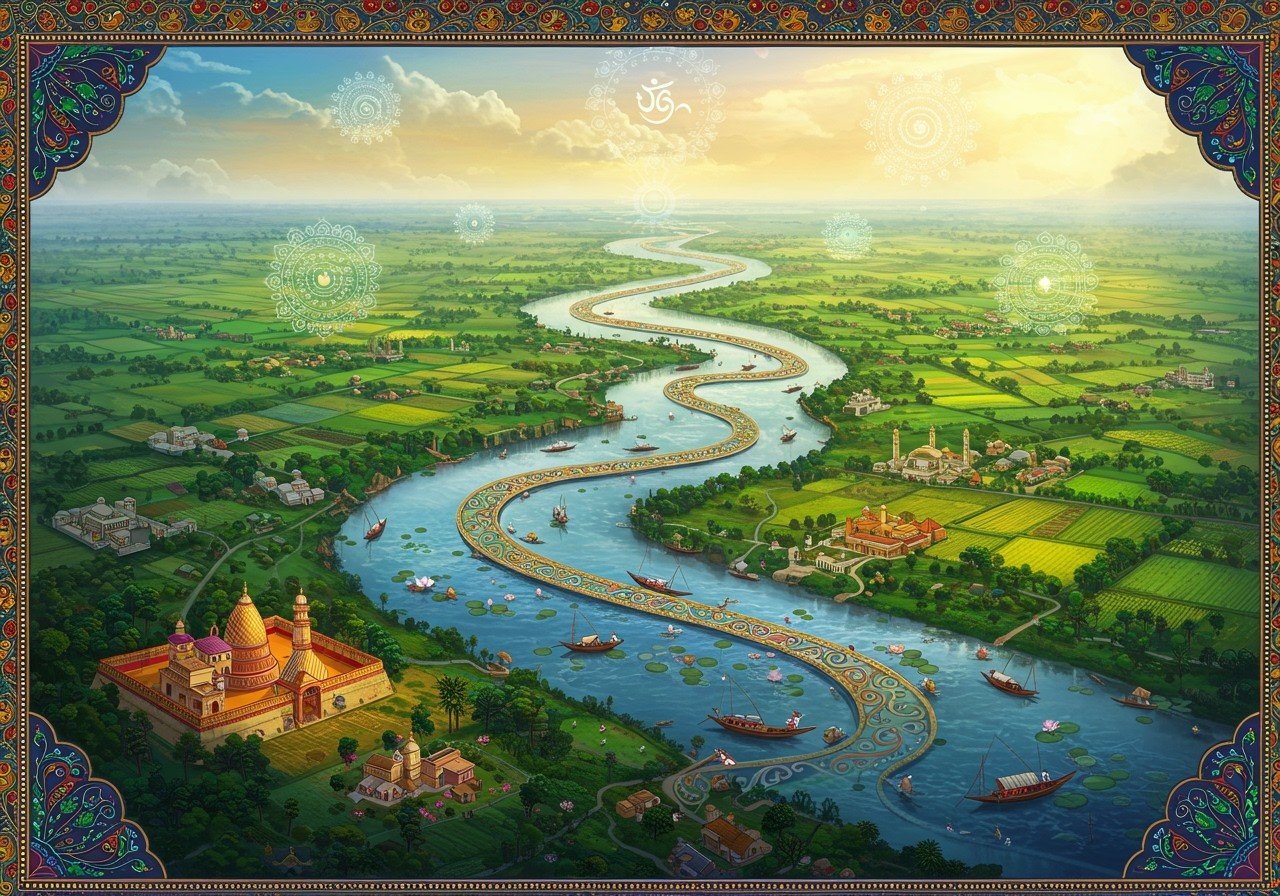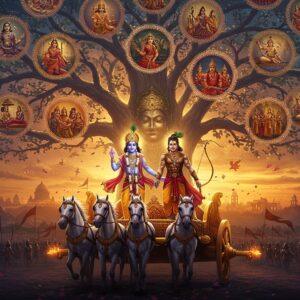
The Karatoya River holds a special place in the hearts of many, weaving through the cultural and ecological tapestry of Bangladesh. This river, steeped in history and lore, has witnessed countless seasons change. From its ancient origins to its present-day form, the Karatoya continues to be a vital waterway, deeply connected to the lives and traditions of the communities it sustains.
Historical Transformations of the Karatoya
Once a major tributary of the mighty Brahmaputra, the Karatoya played a pivotal role in ancient trade routes, its waters carrying not just goods, but stories and cultures. Historical texts and maps, like treasured family heirlooms, tell the tale of the river’s passage through time, showcasing its significance in the region’s history. Over centuries, the river’s course has been shaped by both natural forces and human endeavors, a narrative documented in literature and cartography. Even its name has evolved, a testament to the diverse cultural influences that have graced its banks. Understanding these historical shifts allows us to appreciate the rich and layered significance – both cultural and ecological – that the Karatoya embodies.
The Karatoya Today: Its Course and Cultural Context
Today, the Karatoya River, a gentle giant whispering tales of bygone eras, meanders through the Rajshahi Division of Bangladesh. Its journey begins amidst the verdant Baikunthapur jungles of West Bengal, India, a birthplace shrouded in natural beauty. Flowing through the Bogura District, it becomes an intrinsic part of the local landscape. Pinpointed at 24.12927° N latitude and 89.59307° E longitude, its presence transcends mere geography; it’s a thread woven into the fabric of the local culture.
As of 2025, updated maps reveal the Karatoya’s evolving path through Bangladesh. Its course, like life itself, is not static, having been influenced by natural shifts and human activities. The nearby ancient ruins of Mahasthangarh stand as silent witnesses to the intertwined destinies of the river and the region’s history. This setting serves as a poignant reminder of the Karatoya’s profound influence on the past.
The river’s trajectory significantly impacts regional infrastructure, shaping agricultural practices and urban development. Changes in its course have far-reaching consequences for the communities it sustains. The Karatoya’s waters have long nurtured traditional farming, providing sustenance for families and bolstering local economies.
Mapping the Karatoya: A Confluence of Modern Technology and Ancient Wisdom
Mapping the Karatoya is a pursuit that blends scientific precision with an artistic appreciation for the river’s essence. Today, we employ advanced satellite imagery and GIS technologies, tools that allow us to chart the river’s path with remarkable accuracy. These modern marvels provide invaluable insights into the Karatoya’s current state, capturing every bend and meander.
Yet, the whispers of ancient descriptions offer a captivating glimpse into the past, revealing how people once perceived the river’s flow. Comparing these historical accounts with contemporary data illuminates the remarkable progress of cartography. These ancient maps, though lacking the precision of modern tools, possess a unique charm, reflecting the worldview of early mapmakers.
The true challenge lies in capturing a river that defies stagnation. The Karatoya’s dynamic nature demands adaptability in our mapping techniques. As the river shifts, so too must our strategies for understanding its ever-changing geography. This interplay between old and new enriches our appreciation of the Karatoya’s enduring legacy.
The Karatoya’s Ecological Significance: A Sanctuary of Life
The Karatoya River is a vibrant artery of biodiversity. Its life-giving waters nourish thriving ecosystems, supporting a rich tapestry of species that depend on its flow. This ecological abundance testifies to the river’s crucial role in sustaining the natural world.
Local agriculture flourishes thanks to the river’s benevolent presence. Farmers depend on its waters to irrigate their fields, ensuring food security for communities along its banks. However, the shadow of environmental challenges looms large. Pollution and habitat loss pose a threat to this delicate balance, urging us to act swiftly and decisively.
Protecting the Karatoya’s well-being is paramount to preserving the cultural practices intricately linked to its waters. Traditional rituals often center around the river, reflecting its deep-rooted cultural significance. Maintaining its ecological integrity is not just an environmental imperative; it’s an act of honoring these traditions and securing a future where both nature and culture can thrive.
Cultural Resonance: The Karatoya in Ritual and Remembrance
Culturally, the Karatoya River transcends its physical form; it’s a living embodiment of identity. Communities nestled along its banks celebrate rituals and festivals that pay homage to their connection with this ancient waterway. These gatherings serve as a powerful reminder of shared heritage, strengthening the bonds that unite these communities.
In folklore and literature, the river takes on an almost mythical quality. Stories passed down through generations weave the Karatoya into the region’s narratives. The river becomes a character in tales that reflect the intertwined destinies of humanity and nature.
As the river’s course changes, so too do the cultural practices associated with it. Adaptation becomes a way of life for communities whose lives are interwoven with the river’s story. They discover innovative ways to honor their traditions while embracing the new realities shaped by the shifting waters.
The Karatoya’s Enduring Legacy: A Testament to Resilience
The Karatoya River stands as a timeless testament to resilience – both of nature and the human spirit. It remains an enduring source of inspiration, reminding us of our shared responsibility to cherish this invaluable resource.
Poojn.in: Your Companion on the Path of Tradition
As we reflect on the ever-changing nature of the Karatoya and its significance in traditional practices, we at Poojn.in feel a deep connection to this narrative. Just as the river nourishes the land, we aim to nourish your spiritual journey by offering authentic and readily accessible Puja essentials.
For instance, consider the sacred Bhoj Patra (Birch Bark), often used in sacred texts and rituals. Poojn.in provides access to genuine Bhoj Patra, ensuring that you have the necessary resources for your spiritual practices.
We also recognize the important role of purification rituals in many traditions. The Pobitro Mahasnan Toilo Samagri available on poojn.in provides the necessary components for these sacred baths, simplifying the process of observing traditional practices.
Embracing the Karatoya’s Flow: A Continuous Journey
The Karatoya River flows onward, carrying within its currents the echoes of the past and the aspirations of the future. When we observe its ever-shifting course, we see more than just a river; we see a powerful symbol of life, culture, and community. The updated maps of 2025 remind us of the river’s dynamic nature and its profound impact on the land and its people. Through the lens of advanced mapping techniques and the wisdom of ancient tales, we learn to appreciate the entirety of its journey.
This river sustains both the physical and spiritual landscapes, playing a vital role in agriculture and daily life. Its ecological importance underscores the urgent need for responsible stewardship, protecting its waters and the traditions they support. The Karatoya’s cultural significance shines brightly in festivals, rituals, and stories that keep its legacy alive for generations to come.
By embracing the Karatoya, we honor its past and pave the way for its future. Balancing tradition with the advancements of the modern world ensures that this river continues to inspire and sustain us all. Let us cherish the Karatoya, safeguarding its flow and respecting its integral place in our shared heritage.
Understanding the Karatoya: Frequently Asked Questions
What’s in a name? The Karatoya River is presently known as the “Karatoya,” but it has held many names throughout history, each a reflection of its evolving journey through time and cultural contexts. These names, etched in ancient texts and whispered in local traditions, provide glimpses into how previous generations perceived and revered this sacred waterway.
How do we chart its course today, compared to the past? Modern mapping techniques, including satellite imagery, GPS, and advanced digital cartography, help us understand the Karatoya with incredible detail. This contrasts sharply with the methods of our ancestors, who relied on prominent landmarks and oral traditions to create maps which, while not as precise, offer a unique glimpse into their worldview. These ancient descriptions, though different from today’s data-rich maps, enhance our appreciation for the river’s story.
Why is the Karatoya ecologically vital? The Karatoya River is a cornerstone of the region’s ecological balance. Its waters cradle diverse ecosystems and provide sanctuary to a myriad of species, highlighting the importance of conservation and responsible environmental practices.
Why understand the changing river? Studying the changing course of the Karatoya is vital. It not only helps us understand its impact on communities, agriculture, and the environment but also informs strategies for flood management and conservation efforts, ensuring that the river continues to give back to those who depend on its grace.
How do updated maps benefit local communities? Up-to-date maps (like those from 2025) are essential tools for local communities. They provide accurate information about the river’s course, allowing for better planning in agriculture, flood management, and the wise allocation of precious resources. They empower communities to live in harmony with the river’s natural rhythms.
Are there conservation efforts to protect this precious resource? Yes, there are ongoing and dedicated conservation efforts focused on safeguarding the Karatoya’s biodiversity and ecological balance. These initiatives emphasize sustainable resource management, aiming to protect the river’s health for future generations.
For those seeking to deepen their connection with Bengali traditions, Poojn.in also offers a beautiful selection of Bengali Padma Gita and traditional Hand Pakha (fans) to enrich your spiritual practices. Discover these and other treasures at www.poojn.in .


